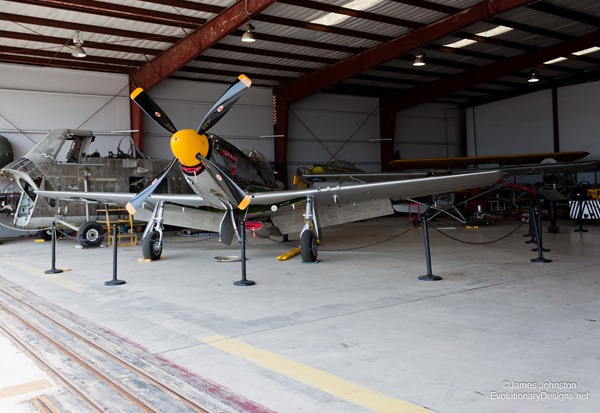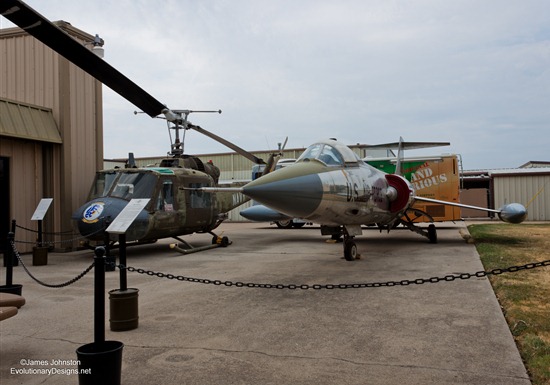Nov 13 2011
Cavanaugh Flight Museum Part 2 – World War II Fighters
Today, I want to revisit the Cavenaugh Flight Museum not in person but, some of the pictures I took during my last trip there last summer. I would love to go back, but the place simply isn’t setup for taking pictures and all the hangars are just to packed with planes and other cool stuff. But I do plan to visit during the next air show. This is when the hangars are open, some of the planes are even open for visitors to sit in!
In the last article, I showed off of some of my favorite pictures I took and I talked about the museum a little but I didn’t go into detail about the planes I shared with you. So today, I will share with you a few of my favorite fighter planes from World War II and give a basic background about each plane.
Eastern/Grumman FM-2 Wildcat
The F4F/FM-2 Wildcat was an important Allied fighter of World War II. It was designed by the Grumman Aircraft Corporation and was the first all-metal, carrier launched fighter that the U.S. Navy purchased. This small but agile fighter was the primary front line fighter of the Navy and Marine Corps at the beginning of World War II. Although these fighters were an important part of the war, it is sometimes forgotten and almost unknown to most World War II fighter fans. But you can sometimes see these fighters in History Channel documentaries and you can see how important they were.
This beauty was one of the last Wildcats built for the U.S. Navy just days before the official Japanese surrender in Tokyo Bay. So this Wildcat is spend most of its military career in storage and was retired in 1947. Then it was restored in 1979.
For more information and specs on this fighter, check it out on the Cavanaugh Flight Museum webpage.
Messerschmitt Me-109/Hispano HA-112
The Messerschmitt Me-109 was the best known German fighter of World War II. It ruled the skies over Europe from 1939 to 1941. Allied forces knew all to well how this plane preformed. They had respect for the Me-109s but was feared by Allied bomber crews. (As a child I remembered my grandfather talk about these fighters as he did bomb runs with his B-17 flight crew.)
This Me-109 was build in Germany in 1943 and was shipped to Spain. At that time, Spain had the rights to use and manufacture these planes, but they where called the Hispano. The Hispano Aviación, the spanish aircraft company, had the right to produce these fighters for the Spanish Air Force, but with Germany having issues providing parts and planes for their own forces, the Spanish company was unable to use the Diamler-Benz DB605 engines during and after the war. So instead, they used a British Rolls-Royce Merlin engine and was Designated the HA-1112.
Cavanaugh’s Me-109 served in Spain until 1967. It was painted in the colors of General Adolf, one Germany’s most famous World War II Aces and has appeared in the movies “Memphis Belle”, “The Tuskegee Airmen”, and few others movies and TV Shows.
For more information and specs on this fighter check it out on the Cavanaugh Flight Museum webpage.
North American P-51D Mustang
The P-51 Mustang is one of the best known fighters of all time. Not only was it elegant in flight, it also had a combination of speed, endurance, handling and firepower that put fear in the heart of the enemy! Even just sitting there, it looks deadly. The Mustang could be used for anything, it was used as a fighter, bomber, dive bomber, reconnaissance, escort of heavy bombers (the big bombers referred to them as “Little Friends”), and then it was use as a race plane.
I mentioned earlier, my grandfather was part of a B-17 bomber crew stationed in Germany, one of few stories he talked about was how these fighters would zip in out and of the clouds hunting enemy fighters and escorted them as far they could before heading back to base. Little Friends were what helped saved many lives during World War II and it is one of my favorite fighters of the war.
The P-51 Mustang had its first dogfight in 1942 and was retired retired from U.S service around 1957 but some nations still had them on active duty until the 1980s. Out of the 15,000 P-51s built, only around 200 survived. And many of them still fly today!
This P-51D was built in 1944 and was assigned to the 9th Air Force,370th Fighter Group, 401st Fighter Squadron and flown by Lt. Hjalmar Johnsen. Then in 1947 is was sold to the the Swedish Air Force. Around 1952/1953 it was sold to the Dominican Reblic and was retired in 1984. The fighter was restored and painted in the colors and markings of Lt. Hjalmar Johnsen while it was in service with 401st Fighter Squadron during the war.
For more information and specs on this fighter check it out on the Cavanaugh Flight Museum webpage.
James
Latest posts by James (see all)
- Random Picture of the Week #84: Arthur Ravenel Jr. Bridge - May 6, 2016
- Random Picture of the Week #83: Lucky’s Rod & Kustom Chevrolet 210 Kustom Shop Car – Invasion Car Show 2014 - April 5, 2016
- Random Picture of the Week #82: Vintage Big Red Cooler on a VW Bug Spotted at the Helping Out Our Neighbors Car Show - March 18, 2016














Nov 14, 2011 @ 14:52:22
Great shots, James. These are awesome, man.
I’ve always been a P51 Mustang fan. That was one of the bad boys of the skies.
I somehow missed the previous post, heading over there next.
Nov 15, 2011 @ 13:58:26
Thanks Jimi. P-51 Mustang is one of my favorites as well.
Nov 16, 2011 @ 03:24:37
Awesome shots!! I love looking at and reading about old planes – completely fascinate me! Well done James. BTW, I agree, the P-51 is a marvel of engineering and sexyness!
Nov 16, 2011 @ 08:12:07
Thanks Adam, They are dead sexy and I have been lucky enough to see one of these in flight.
Abandoned 404 Martin Passenger Plane Tail Number Found Near Paris, TX
Jul 24, 2012 @ 16:29:55
[…] display for the public. A few the plans I found they had were a B-17 Flying Forest (bomber WWII), P-51 Mustang (WWII), F-86 Sabre, and a F4U […]
Abandoned 404 Martin Passenger Plane Found Near Paris, TX - James Johnston
Mar 12, 2013 @ 01:32:19
[…] display for the public. A few the plans I found they had were a B-17 Flying Forest (bomber WWII), P-51 Mustang (WWII), F-86 Sabre, and a F4U […]